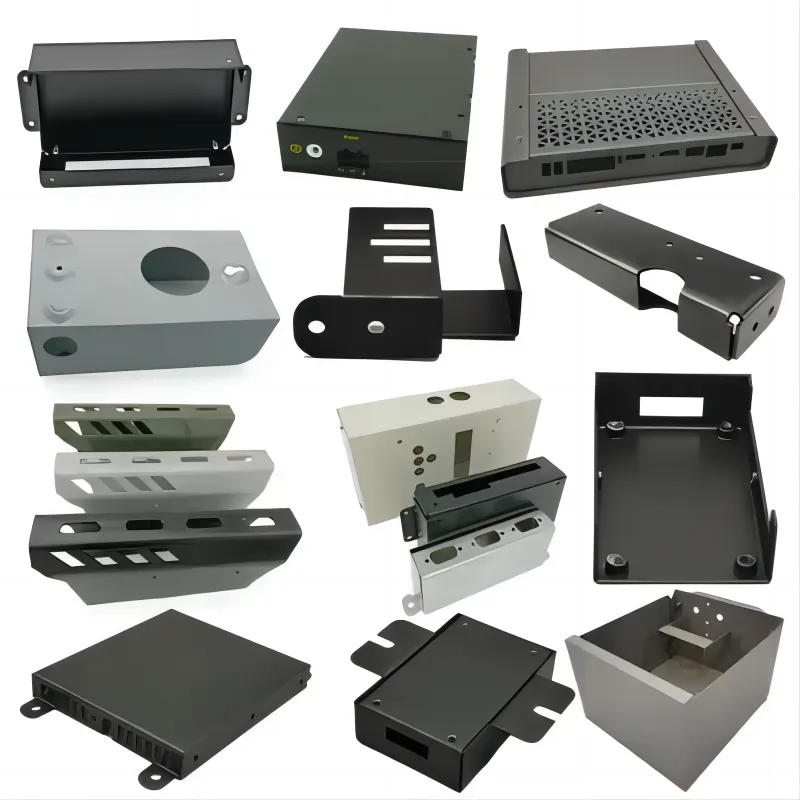Original Equipment Manufacturers (OEMs) work in highly competitive markets. They must deliver products that not only function well but meet regulatory, durability and user expectations. Custom Metal Enclosures offer OEMs the control, performance, and protection required in electronics. By using metal enclosures that are custom-designed and fabricated, OEMs ensure components are protected against environmental stress, mechanical shock, heat, corrosion, and electromagnetic interference. Custom Metal Enclosures enable OEMs to integrate cooling features, mounting points, sealing, and aesthetic details from the earliest design phases, reducing issues downstream and improving product reliability.
OEMs that invest in Custom Metal Enclosures gain advantages in product lifespan, customer satisfaction, and brand reputation. Custom enclosures are also essential where off-the-shelf solutions fall short in meeting stricter standards or unique form factors.
Custom Metal Enclosures allow OEMs to choose materials that best suit their environments. Materials like stainless steel, aluminum, cold-rolled or hot-rolled steel each bring trade-offs in strength, weight, corrosion resistance, cost, and manufacturability. OEMs selecting stainless steel may gain greater corrosion resistance and strength but pay more in cost and machining effort; aluminum may reduce weight and cost but require careful finishing to prevent corrosion or damage.
OEMs use Custom Metal Enclosures to engineer precise thicknesses and mechanical strength. For example, thicker sheet metal improves impact resistance and structural rigidity, especially in industrial or outdoor electronics applications.
Custom Metal Enclosures are critical for meeting environmental protection requirements. OEMs often need to design to IP ratings (Ingress Protection), NEMA ratings or other local/international standards. Proper sealing, gasket design, door or lid fitment, and enclosure locking mechanisms must be engineered. Off-the-shelf enclosures sometimes lack precisely matching features for sealing or environmental resistance, meaning OEMs prefer custom designs.
Regulatory compliance (electrical safety, EMC / EMI, thermal regulation, fire safety etc.) often demands that enclosures support grounding, shielding, spacing, and material certifications. Custom Metal Enclosures give OEMs the ability to ensure that all these requirements are met at design time rather than as afterthoughts.

Manufacturing tolerances in sheet metal work are critical. OEMs investing in Custom Metal Enclosures depend on precise dimensional and angular tolerances to guarantee parts fit, doors close, panels align, and assemblies seal properly. Standards such as ISO 2768 and others give general tolerance classes when specific tolerances are not indicated. OEMs typically require tighter tolerances for features that interface, such as hinge points, lid closures, mounting holes. Variation in material properties, bend radius, tooling precision, and forming process all influence tolerance control.
Design guidelines help OEMs understand how tolerances stack up across features, how bend reliefs, hole spacing, minimum hole size relative to material thickness, and minimal distance from bends affect manufacturability.
Custom Metal Enclosures often require investment in tooling (dies, molds, fixtures). For OEMs, the cost of tooling can be large for low-volume production, but when volume scales up, the amortized cost per unit comes down significantly. OEMs weigh the upfront cost of custom tooling against long-term savings: fewer modifications, fewer failures in the field, better customer satisfaction, reduced warranty claims.
Batch size, unit cost, material cost, finishing, assembly, and post-processing all play into total cost. OEMs often benefit by optimizing the design for manufacturability: reducing complex bends, minimizing number of parts to weld, optimizing cuts and folding to reduce waste, choosing standard hardware etc.
Electronics always generate heat. OEMs use Custom Metal Enclosures to integrate ventilation slots, convection paths, heat sinks, or even forced-air cooling as needed. Without custom design, cooling performance often suffers, which can reduce lifetime or reliability of components.
Electromagnetic interference (EMI) is tackled by Custom Metal Enclosures via continuous metal surfaces, conductive gasketing, proper seams, shielding materials, and properly engineered joints. OEMs cannot rely on generic enclosures to provide sufficient EMI performance unless modified.
Serviceability is another major factor: OEMs need to ensure that enclosures allow access for repair, maintenance, inspection. Custom designs permit design for fasteners, removable panels, cable routing, mounting brackets and enclosures that make assembly and disassembly easier, reducing field service costs.
Parameter |
Typical OEM Requirement |
Reason / Impact |
Material type |
Stainless steel 304 / 316; aluminum 6061; cold-rolled steel |
Determines corrosion resistance, cost, weight |
Sheet thickness (mm) |
1.0 – 5.0 mm depending on size, load, protection needed |
Thicker material improves strength but increases weight and cost |
Bend radius |
1.5-3 × material thickness for steel; 2-4 × thickness for aluminum |
Prevents cracking, ensures bending integrity |
Tolerances (linear) |
±0.1 mm for critical dimensions; ±0.2-0.3 mm for non-critical |
Ensures proper fit of panels, door closures, hardware |
Tolerances (angular) |
±0.5° or tighter for hinged or mating surfaces |
Ensures alignment, sealing and consistency |
Surface finish |
Powder coating, painting, anodization, brushed finish |
Impacts corrosion resistance, aesthetics, environmental resistance |
Environmental sealing |
Gasketed seams, IP/NEMA seals, sealing via welds or lips |
Needed for dust/water ingress protection |
EMI/EMC features |
Conductive gasketing, continuous metal joints, proper grounding points |
Needed for compliance, product reliability in noisy environments |
OEMs that use Custom Metal Enclosures are able to present their products as premium, robust, and well-engineered. The fit, finish and feel of enclosures contribute significantly to customer perception. Making panels flush, seams even, surfaces uniform, edges clean—all are possible with custom metal work. This helps in markets where appearance, perceived build quality and durability matter.
Off-the-shelf enclosures may meet basic protection needs but often underperform in real-world conditions. Moisture ingress, overheating, vibration, EMI can all lead to component failures. By investing in Custom Metal Enclosures designed to handle the specific environmental, mechanical, and thermal stresses expected in the field, OEMs reduce failure rates, returns, repairs and warranty claims—leading to cost savings and better customer satisfaction.
OEMs frequently iterate prototypes or small runs before final production. Custom Metal Enclosures allow OEMs to test fit, thermal behavior, serviceability early. Precision in sheet-metal fabrication helps OEMs get from prototype to mass production without major redesigns. This reduces delays, minimizes risk, and ensures that the product delivered meets both function and regulatory safety.
OEMs must partner with metal fabrication specialists that provide strong engineering input. Such fabricators offer design feedback (Design for Manufacturability), material suggestions, tool and die expertise, and cost optimization suggestions. A good fabricator helps OEMs pre-empt issues with bending, cutting, forming, welding, finishing etc.
OEMs provide detailed CAD models, engineering drawings specifying all critical dimensions, tolerances, finish, sealing, mounting, and environmental specs. Prototyping and testing under real-use conditions (thermal cycling, vibration, humidity etc.) ensure that Custom Metal Enclosures hold up. Design validation saves money later.
OEMs require consistent production quality. Quality control of Custom Metal Enclosures involves inspection of dimensions, surface finish, mechanical strength, sealing performance, and regulatory compliance (e.g. IP, EMI, safety standards). Certifications and testing may be required. Ensuring that both prototype and production units meet these standards is essential.
Lead times vary depending on complexity, materials, tooling, finishing, and volume. For simple small-volume custom enclosures, prototyping may take a few days to weeks. For fully custom designs with dedicated tooling and high volumes, lead time may extend further. Collaborating early with fabricators shortens turnaround.
OEMs evaluate trade-offs: strength, corrosion resistance, and durability versus cost and weight. They often perform material selection analysis, considering lifespan, environment, exposure to moisture or chemicals, heat load, and regulatory requirements. Often higher material cost is justified by reduced maintenance and longer service life.
Critical dimensions (like mating surfaces, hinges, sealing edges) often have tight tolerances: ±0.1 mm or even tighter when needed. Less critical features (panel size, non-mating surfaces) may accept looser tolerances of ±0.2-0.3 mm. Angular tolerances commonly around ±0.5°, depending on material and bend operations.
OEMs incorporate design for manufacturability to reduce needless complexity. They reduce the number of distinct parts, avoid over-specifying tolerances on non-critical surfaces, choose finishing and sealing only where needed, plan assembly and maintenance access. Investing in prototypes and thorough testing also helps avoid expensive errors in production or field.


Copyright © 2024 by Xiamen Tongchengjianhui Industry & Trade Co., Ltd. - Privacy policy